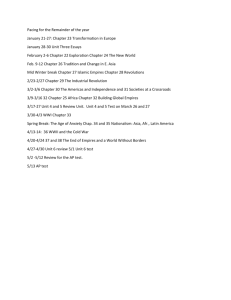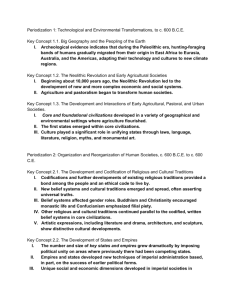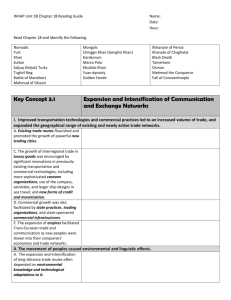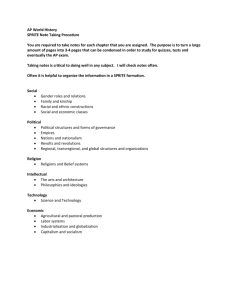Period #3: Regional and Transregional Interactions, c. 600 - 1450 C.E.
advertisement
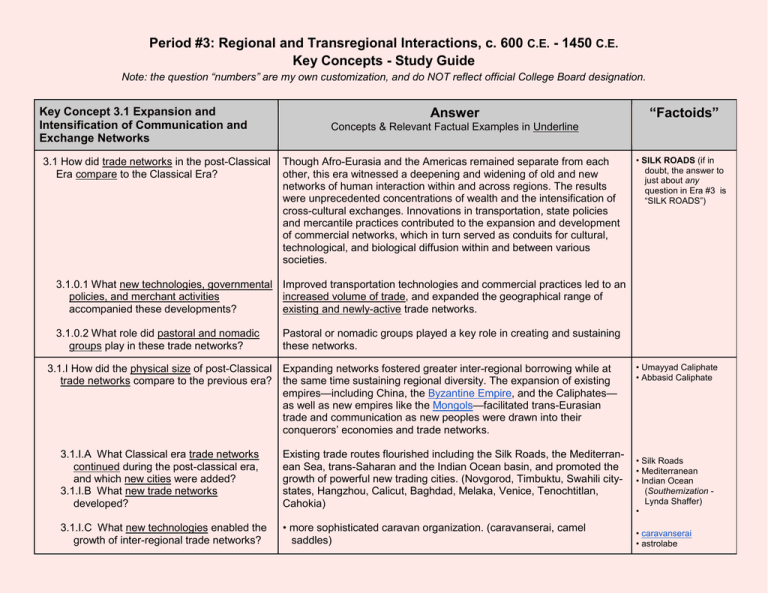
Period #3: Regional and Transregional Interactions, c. 600 C.E. - 1450 C.E. Key Concepts - Study Guide Note: the question “numbers” are my own customization, and do NOT reflect official College Board designation. Key Concept 3.1 Expansion and Intensification of Communication and Exchange Networks 3.1 How did trade networks in the post-Classical Era compare to the Classical Era? Answer “Factoids” Concepts & Relevant Factual Examples in Underline Though Afro-Eurasia and the Americas remained separate from each other, this era witnessed a deepening and widening of old and new networks of human interaction within and across regions. The results were unprecedented concentrations of wealth and the intensification of cross-cultural exchanges. Innovations in transportation, state policies and mercantile practices contributed to the expansion and development of commercial networks, which in turn served as conduits for cultural, technological, and biological diffusion within and between various societies. • SILK ROADS (if in doubt, the answer to just about any question in Era #3 is “SILK ROADS”) 3.1.0.1 What new technologies, governmental Improved transportation technologies and commercial practices led to an policies, and merchant activities increased volume of trade, and expanded the geographical range of accompanied these developments? existing and newly-active trade networks. 3.1.0.2 What role did pastoral and nomadic groups play in these trade networks? Pastoral or nomadic groups played a key role in creating and sustaining these networks. 3.1.I How did the physical size of post-Classical trade networks compare to the previous era? Expanding networks fostered greater inter-regional borrowing while at the same time sustaining regional diversity. The expansion of existing empires—including China, the Byzantine Empire, and the Caliphates— as well as new empires like the Mongols—facilitated trans-Eurasian trade and communication as new peoples were drawn into their conquerors’ economies and trade networks. 3.1.I.A What Classical era trade networks continued during the post-classical era, and which new cities were added? 3.1.I.B What new trade networks developed? Existing trade routes flourished including the Silk Roads, the Mediterranean Sea, trans-Saharan and the Indian Ocean basin, and promoted the growth of powerful new trading cities. (Novgorod, Timbuktu, Swahili citystates, Hangzhou, Calicut, Baghdad, Melaka, Venice, Tenochtitlan, Cahokia) 3.1.I.C What new technologies enabled the growth of inter-regional trade networks? • more sophisticated caravan organization. (caravanserai, camel saddles) • Umayyad Caliphate • Abbasid Caliphate • Silk Roads • Mediterranean • Indian Ocean (Southernization Lynda Shaffer) • • caravanserai • astrolabe Period #3: Regional and Transregional Interactions, c. 600 C.E. - 1450 C.E. Key Concepts - Study Guide • use of the compass, astrolabe, and larger ship designs in sea travel • and new forms of credit and monetization (bills of exchange, credit, checks/banking houses) 3.1.I.D What factors encouraged commercial growth? • New state practices (the minting of coins, use of paper money) • New trading organizations (the Hanseatic League) • New state-sponsored commercial infrastructures (Grand Canal in China) 3.1.8.E How did the expansion of empires & trade networks affect the relationship between peoples inside vs. outside those “zones?” The expansion of existing empires (China, Byzantine Empire, Caliphates) as well as new empires (Mongols) facilitated trans-Eurasian trade and communication as new peoples were drawn into their conquerors’ economies and trade networks. 3.1.II What were the effects of migration? 3.1.II.A What basic understandings of environment and technology did postclassical traders need to conduct their business? The expansion and intensification of long-distance trade routes often depended on people’s understanding of a particular regional environment and their subsequent technological adaptations to them. • the way Scandinavian Vikings used longboats to travel in coastal & open water, rivers & estuaries • the Arabs and Berbers adapted camels to travel across and around the Sahara • central Asian pastoral groups used horses to travel in the steppes) 3.1.II.B What were the environmental effects of migration? Some migrations had significant environmental impact. • the migration of the agricultural Bantu-speaking peoples in forested regions of Sub-Saharan Africa • the maritime migrations of the Polynesian peoples who cultivated transplanted foods & domesticated animals as they moved to new islands 3.1.II.C … linguistic effects of migration? Some migrations and commercial contacts led to the diffusion of languages throughout a new region or the emergence of new languages • the spread of Bantu languages • the new language of Swahili which developed in E African coastal areas • the spread of Turkic and Arabic languages 3.1.III How did trade networks as a whole develop in the post-classical era? Cross-cultural exchanges were fostered by the intensification of existing or the creation of new networks of trade & communication. • dhow • junk • checks • “flying cash” Period #3: Regional and Transregional Interactions, c. 600 C.E. - 1450 C.E. Key Concepts - Study Guide 3.1.III.A Why and where did Muslim trade networks change? Islam expanded from the Arabian Peninsula to many parts of AfroEurasia due to military expansion and the activities of merchants and missionaries. 3.1.III.B What institutions did merchants create to foster both trade and cultural diffusion? In key places along important trade routes, merchants set up diaspora communities where they introduced their own cultural traditions into the indigenous culture. • Muslim merchant communities in the Indian Ocean region • Chinese merchant communities in Southeast Asia • Sogdian merchant communities throughout Central Asia • Jewish communities in the Mediterranean, Indian Ocean basin, or along the Silk Roads 3.1.III.C How well did post-classical societies know/understand each other? The writings of certain inter-regional travelers illustrate both the extent and the limitations of inter-cultural knowledge and understanding. • Ibn Battuta • Marco Polo • Xuangzang 3.1.III.D How did post-classical trade affect the diffusion of literary, artistic, and cultural traditions? Literary, artistic, and cultural traditions diffused. • the influence of Neo-Confucianism and Buddhism in East Asia, Hinduism and Buddhism in SE Asia • the influence of Islam in sub-Saharan Africa and Southeast Asia • the influence of Toltec/Mexica and Inca traditions in Meso- and Andean America 3.1.III.E How did post-classical trade affect the diffusion of scientific and technological traditions? Increased cross-cultural interactions also resulted in the diffusion of scientific and technological traditions. • the influence of Greek and Indian mathematics on Muslim scholars • the return of Greek science and philosophy to western Europe via Muslim al-Andalus in Iberia • the spread of printing and gunpowder technologies from East Asia into the Islamic empires and into Western Europe 3.1.IV What were the biological effects of post-classical trade? There was continued diffusion of crops and pathogens throughout the Eastern Hemisphere along the trade routes. Muslim Agric Rev 3.1.IV.A What new foods, crops, and agricultural practices diffused? • Bananas in Africa • New rice varieties in East Asia • Muslim Agric Rev Period #3: Regional and Transregional Interactions, c. 600 C.E. - 1450 C.E. Key Concepts - Study Guide 3.1.IV.B What diseases and pathogens also The spread of epidemic diseases, including the Black Death, followed spread via post-classical trade networks? the well-established paths of trade and military conquest. Key Concept 3.2 Continuity & Innovation of State Forms and their Interactions Answer Concepts & Relevant Factual Examples in Underline 3.2 How did state formations develop in the post- State formation in this era demonstrated remarkable continuity, classical era? innovation and diversity in various regions. In Afro-Eurasia some states attempted, with differing degrees of success, to preserve or revive imperial structures, while smaller, less-centralized states continued to develop. The expansion of Islam introduced a new concept—the caliphate—to Afro-Eurasian statecraft. Pastoral peoples in Eurasia built powerful and distinctive empires that integrated people and institutions from both the pastoral and agrarian worlds. In the Americas, powerful states developed in both Mesoamerica and the Andean region. Empires collapsed and were reconstituted; in some regions new state forms emerged. 3.2.I.A How did post-classical states avoid the mistakes of classical empires in the regions where classical empires collapsed? Most reconstituted governments following the collapse of empires, (• Byzantine Empire • Sui, Tang, & Song Chinese dynasties) combined traditional sources of power and legitimacy. (• patriarchy • religion • land-owning elites) with innovations better suited to the current circumstances. (• new methods of taxation • tributary systems • adaptation of religious institutions) 3.2.I.B What new forms of governance emerged? In some places, new forms of governance emerged, including those developed in various Islamic states. • Abbasids • Muslim Iberia • Delhi sultanates • Mongol Khanates • city-states (in the Italian peninsula, E Africa, SE Asia) 3.2.I.C How & where did governmental diffusion occur? Some states synthesized local and borrowed traditions. (• Persian traditions influencing Islamic states • Chinese traditions influencing Japan) 3.2.I.D How did states in the Americas develop? In the Americas, as in Afro-Eurasia, state systems expanded in scope and reach: networks of city-states flourished in the Maya region, and, at “Factoids” Period #3: Regional and Transregional Interactions, c. 600 C.E. - 1450 C.E. Key Concepts - Study Guide the end of this period, imperial systems were created by the Mexica (“Aztecs”) and Inca. 3.2.II What technological and cultural exchanges did states encourage? Key Concept 3.3 Increased Economic Productive Capacity and its Consequences 3.3 What were the overall worldwide economic trends? 3.3.I.A What new innovations affected agriculture in the postclassical era? Inter-regional contacts and conflicts between states and empires encouraged significant technological and cultural transfers. (between Tang China and the Abbasids, across the Mongol empires, during the Crusades. Answer Concepts & Relevant Factual Examples in Underline Changes in trade networks resulted from and stimulated increasing productive capacity, with important implications for social and gender structures and environmental processes. Productivity rose in both agriculture and industry. Rising productivity supported population growth and urbanization but also strained environmental resources and at times caused dramatic demographic swings. Shifts in production and the increased volume of trade also stimulated new labor practices, including adaptation of existing patterns of free and coerced labor. Social and gender structures evolved in response to these changes. Agricultural production increased significantly due to technological innovations. • Champa rice varieties • chinampa field systems • waru waru raised field cultivation in Andean areas • improved terracing techniques • horse collar 3.3.I.B How and why did crops migrate? In response to increasing demand in Afro-Eurasia for foreign luxury goods, crops were transported from their indigenous homelands to equivalent climates in other regions. 3.3.I.C How did textile and porcelain pro- duction develop? Chinese, Persian, and Indian artisans and merchants also expanded their production of textiles and porcelains for export; industrial production of iron and steel expanded in China. “Factoids” Period #3: Regional and Transregional Interactions, c. 600 C.E. - 1450 C.E. Key Concepts - Study Guide 3.3.II Why did some post-classical urban areas decline, while others prospered & grew? 3.3.II.C What roles did cities play in their societies? 3.3.III How did social and labor systems develop during the postclassical era? 3.3.III.A What pre-existing labor systems continued? Factors that contributed to declines of urban areas in this period included invasions, disease, the decline of agricultural productivity, and the Little Ice Age Factors that contributed to urban revival included the end of invasions, the availability of safe and reliable transport, the rise of commerce and the warmer temperatures between 800 and 1300. Increased agricultural productivity and subsequent rising population and greater availability of labor also contributed to urban growth. While cities in general continued to play the roles they had played in the past as governmental, religious and commercial centers, many older cities declined at the same time that numerous new cities took on these established roles. NOTE: Students should be able to explain the cultural, religious, commercial and governmental function of at least TWO major cities. • free peasant agriculture • nomadic pastoralism • craft production • guild organization • coerced/unfree labor • government-imposed labor taxes & military obligations 3.3.III.B How did social and gender hierarchies develop? As in the previous period, social structures were shaped largely by class and caste hierarchies. Patriarchy persisted; however, in some areas, women exercised more power and influence, most notably among the Mongols and in West Africa, Japan and Southeast Asia. 3.3.III.C What new labor forms developed? New forms of coerced labor: • serfdom in Europe and Japan • elaboration of mit’a in Inca Empire Free peasants resisted attempts to raise dues and taxes by staging revolts. (China & Byzantine Empire) The demand for slaves for both military and domestic purposes increased particularly in central Eurasia, parts of Africa and the eastern Mediterranean 3.3.III.D Who did some gender roles and family structures change? The diffusion of Buddhism, Christianity, Islam and Neo-Confucianism often led to significant changes in gender relations and family structure. Period #3: Regional and Transregional Interactions, c. 600 C.E. - 1450 C.E. Key Concepts - Study Guide
